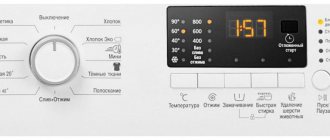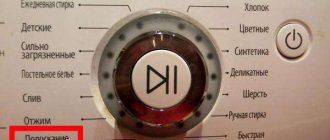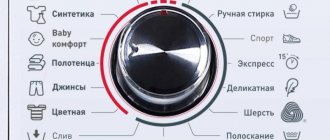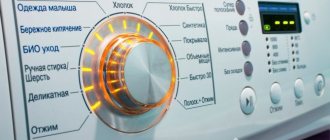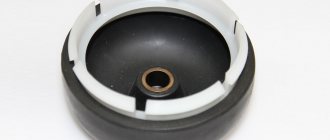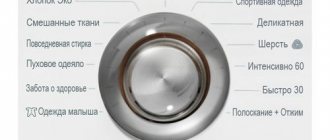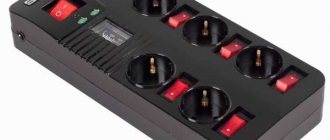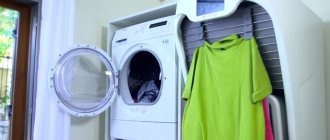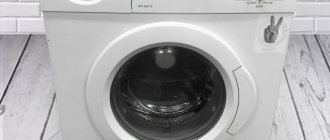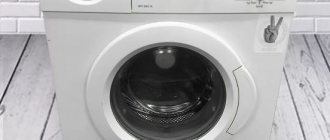The automatic washing machine learned to spin clothes back in the 40s of the twentieth century. This made the washing process much easier, because dealing with heavy bedspreads and duvet covers required a lot of effort. Today such a function exists in any SMA. Many consider it as an automatic operation of the device, which is mandatory for washing programs. This is a big misconception, since the regime’s capabilities in terms of application are much wider. To use it profitably, you need to at least know what the spin icon on a washing machine looks like, and at the most, understand all the nuances of its use.
What is a mode and how is it designated?
The spin mode is designed to remove excess moisture from laundry after washing . This option is included in most wash programs and can also be selected separately on the control panel of the washing machine.
In most washing machine models, this mode is indicated by a curled (twisted) spiral symbol. Also, a number of manufacturers add an additional verbal description to the picture.
The spin intensity itself can be different, determined depending on the choice of program, and takes into account the type of laundry.
Symbol
Many people are interested in what the spin icon looks like. It is represented by a twisted spiral that looks like a snail. The difference may be the number of turns, but this does not matter. If such a picture is crossed out, this means that the function is not available in the installed program.
This function is placed separately in the machine so that it is only possible to spin things, occasionally combining this process with rinsing.
The number of revolutions depends on the specific model of the machine, ranging from 400 to 1,800 rotations per minute. The degree of drying of things depends on the speed of the drum rotation.
Classification
Manufacturers of washing machines produce a wide range of models with different characteristics. There are seven generally accepted spin classes. It is coded in Latin letters: from “A” to “G”. The value of this parameter is determined in the laboratory as a result of tests.
To determine the efficiency index, laundry is weighed before and after washing . Subtract the smaller value from the larger value and divide by the weight of the laundry before washing. The result obtained is converted into percentages. The spin class is one of the criteria for energy efficiency: with intensive rotation of the drum, more intensive electricity consumption occurs.
The efficiency index calculated is decisive for assigning a class. The lower the indicator, the more efficient the washing machine:
Class A. Indicator A is the highest. This efficiency index is achieved by intensive spinning at the highest speeds, when the drum rotation reaches 1,600 rpm. The remaining moisture in the laundry is up to 45%.- Class B. The next most efficient class is B. With it, the residual moisture ranges from 44 to 52%. Processing is achieved by rotating the drum at an intensity of 1,400 rpm.
- Class C. This class is determined by a rotation of 1,200 rpm. At the same time, the laundry comes out of the drum more damp - up to 63%. This indicator indicates sufficient functionality of the washing machine.
- Class D. The residual moisture content of the laundry after this treatment ranges from 63 to 71%. Spinning takes place at an intensity of 1,000 rpm. Class “D” cars are chosen by buyers who are looking for the optimal balance of price and quality.
- Class E. The residual humidity in class E washing machines ranges from 72 to 81%. Spin – 800 rpm. The laundry remains damp after finishing work.
- Class F. Dryness of clothes in class “F” is up to 20%. Spin – low, 600 rpm.
- Class G. This class is inherent in washing machines with low drum rotation speeds. Residual moisture on linen is 90%. As a result, things after such treatment require a long drying time.
In addition to the standard spin cycle, combination washing machines may have a drying function.
Spin classes in the washing machine
Modern models allow you to remove clothes after washing in an almost dry state. From the selected program, conditions are established that allow you to obtain the desired result.
Class, in other words, drying of clothes, is ensured by slow or fast rotation of the drum. The characteristic is calculated experimentally. First, the laundry is weighed before being loaded into the machine. Then she washes it and spins it. The second value is divided by the first and multiplied by 100%.
Varieties of drying classes
There are 7 spin classes in total. They are designated by Latin letters of the alphabet. Modern cars have only four classes: A, B, C and D.
Category “A” - due to the rapid rotation of the drum, the laundry is completely wrung out. The humidity of washed items is less than 50%. This includes machines with the highest possible speed (more than 1000 times).
Class “B” - the humidity of things reaches no more than 54%. The motor spins the drum up to 1000 times per minute.
C – from 55 to 63% (from 800 rpm).
D – from 64 to 72% (from 400 rpm).
Categories "D" to "G" are not used in machines due to the fact that washed clothes are removed completely damp and must be wrung out manually. This spin class refers to old-style machines.
The quality of drying is affected by the number of rotations per minute performed by the drum. The more revolutions, the drier the laundry removed will be. Automatic machines with class “A” or “B” can reach from 1200 to 2000 rpm.
Such models usually have high capacity and standard or large dimensions. Due to the high speed and strong pressing of the laundry against the walls of the tank, although it turns out to be almost dry, ironing it becomes problematic.
Things wrinkle to such an extent that they cannot be ironed without additional moisture. So high speeds are not an indicator of high-quality washing. The machine’s ability to dry clothes at maximum drum rotations increases the cost and is a marketing ploy to attract buyers.
Narrow models are best purchased with low speeds (from 800 rpm). Due to the strong rotation of the drum, the equipment begins to vibrate strongly, especially if there is too much laundry in it or it is laid out unevenly. The same can happen with machines with a load of about 6 kg.
Recommendations for choosing a class
Choosing a washing machine based on how fast the drum spins makes you wonder if it's worth paying more to get drier clothes after washing. If drying things in the air is problematic (little space, humid climate, etc.), then a high spin class will be simply necessary.
A and B make the laundry almost dry . But using the option to the maximum can also damage thin and delicate material. If you don’t plan to often use maximum speed, then you can choose a washing machine with a lower class without overpaying for an unclaimed option.
Classes C and D are considered to be European standards. This is the best option for mid-latitudes. The laundry that comes out of the drum is still damp, but can be completely dried by hanging it in the air.
F and G are the most modest option , which is sold in cheap models of washing machines. This washing machine is more suitable for hot regions with high air temperatures.
The classification of spin levels and their letter coding helps to simplify the selection problem and make the right decision when purchasing a washing machine.
Additional washing modes
- "Wool".
Not available on all models. Ideal for cleaning knitted items containing natural wool. The drum rotates gently, as in a delicate wash. The water heats up to no more than 40°C, so things don’t “shrink” or shed. Little liquid is used when washing. The detergent should be specifically designed for woolen clothes. Fully loading the drum in this mode is not recommended. It should be no more than 2/3 full. This is due to the fact that wet woolen items weigh a lot, which can overload the machine. Optimally - 2-3 things. Spinning occurs at minimum speed. - "Sport".
This mode uses pre-washing or soaking to optimally remove dirt and sweat odors from complex fabrics (for example, membrane) from which sportswear is made. To improve the quality of washing, experts recommend using bioactive powders that better remove stubborn dirt. - "Wash in cold water." Suitable for both colored items that are prone to shedding and delicate fabrics. Spin at very low speeds or absent at all.
- "Shoes".
The selected program will help remove dirt from textile sneakers and sneakers. Shoes must be placed in a special bag. One pair is washed per cycle. - "Kids' things".
Features high temperature and additional rinsing. The mode requires large amounts of electricity and water. It is also suitable for allergy sufferers, since the powder is washed off as thoroughly as possible so as not to irritate the baby’s delicate skin. - "Night mode".
The quietest program. In order not to disturb the sleep of household members, sound signals and spin are not used here. Therefore, it is imperative to provide a place where to dry completely wet things from which water will drip. The washing machine turns off automatically. Allows you to save money for those whose water tariff changes (cheaper at night). - "Volume things." Suitable for washing outerwear and other items that strongly absorb water. With this program, only one item is loaded into the drum, otherwise the machine can be overloaded. The washing time here is one and a half hours. Things don't lose their shape. This function allows you to wash soft toys.
- "Shoes". Processing time – no more than 50 minutes. The rotation of the drum is gentle, spinning is not used. Shoes must be in a special bag. Found only in the latest models of washing machines.
- "Steam treatment." Items that cannot be washed can be refreshed by steaming. Under the influence of high temperature, the water in the tank turns into hot steam and enters the drum through the holes. Steam effectively fights fungi and bacteria, and also eliminates odors of sweat, mustiness and dampness. Suitable for disinfecting children's toys, small carpets and delicate items, which are not damaged at all during the treatment process.
- "Daily wash"
(“New items” or “Express wash”). In this mode, newly purchased or lightly soiled items are washed. The program lasts no more than half an hour. - "Outerwear". Allows you to wash jackets that strongly absorb water, or, conversely, those with a water-repellent coating.
- “Hypoallergenic wash” (“Hygiene”, “Super rinse”, “Aqua+”, etc.). A mode that provides additional rinsing to maximize the washing out of detergent residues from the fabric fibers. The treatment takes place at a temperature of 60°C, so this program is not suitable for delicate fabrics. Before placing items in the drum, you need to study the information on the label. The mode is long and not economical, since high heating requires additional energy consumption, and rinsing requires a large volume of water.
- "Incomplete loading." If there are few things accumulated, and you need to wash them urgently, then the half-load mode is suitable. Processing is much faster than in conventional programs and with less water. At the same time, all the main stages of washing are preserved.
- "Easy ironing" There is no intermediate spin, and the final spin takes place at low speeds. When rinsing, an increased volume of water is used. At the end, steam treatment is carried out, and strong creases are smoothed out. This will make it easier to iron wrinkled fabrics such as linen later. But this program cannot be called full-fledged ironing, since small folds still remain. In this program, less powder is added so that it does not remain as stains on clothes. The drum is filled to 2/3 of the usual load.
- "Drying". If there is no place to hang things to dry, you can dry them directly in the machine. But ironing will be quite difficult, as the clothes dry out.
How to enable and use the option?
Spin is a function that is included in most washing programs and occurs as follows:
After the wash is completed, the water is drained. The laundry still remains very wet.- The spin cycle starts automatically at a certain intensity.
- The drum begins to rotate at high speed. The removal of moisture from things occurs due to centrifugal force - things in the drum are strongly pressed against the walls.
- The water squeezed out of the laundry is pumped out of the tank using a pump into the sewer system.
This process is quite noisy. This is due to the intense rotation of the drum and the operation of the pump.
Most washing machines allow you to adjust (downward) the spin intensity when choosing standard modes. When the indicator decreases, the laundry will remain more damp than with more intense exposure.
Most equipment manufacturers provide the ability to select spin as a separate program. This is a convenient option; with its help, it is possible to squeeze out items that remain very wet after the standard processing cycle.
You don’t even have to take them out of the drum , but immediately select the “spiral” icon on the control panel.
It is also possible to use the “spin” for hand-washed laundry. Wet items are simply placed in the drum, and the “spiral” is selected on the control panel. At the same time, the intensity of laundry processing can (and even should) be adjusted taking into account the type of fabric and type of items.
Even a powerful washing machine has the ability to select a low speed. This may be necessary when processing delicate, light fabrics that can become deformed, wrinkled, or even tear when the drum rotates intensively. Rotating the drum at high speeds will undoubtedly make the thing drier, but it can also ruin it.
The video will show you how to set only “Spin” on an LG washing machine:
Can it be machine washed if it says hand wash?
In addition, in the instructions for the machine, the manufacturer indicates that the drum can be loaded in this mode only to half the permissible maximum load. ... The hand wash symbol on almost all washing machines is the same. This is a drawn basin of water and a hand.
Interesting materials:
How many square meters are in a package of liquid wallpaper? How long does it take to heal a torn ankle ligament? How many medications can you carry on an airplane? How long does it take to depreciate a car? How old was Schwarzenegger in Terminator 1? How many years are sick leave certificates stored at the enterprise? How long do dried fruits last? How long does the bailiff keep the writ of execution? How old is my guardian angel? How many years does it take to study to become a designer?
What do we wash and how do we spin it?
When choosing a new washing equipment, you need to pay attention to the number and list of standard programs provided by the manufacturer, and also have the opportunity to change the parameters to suit your requirements, as an option - reduce the spin intensity.
Cotton
Items made from natural cotton are washed at an average temperature of 40-60ºС. Hotter water can cause shrinkage, and in colored materials it can reduce the brightness of the colors. Excess moisture can be removed from cotton items at 800 - 1,000 rpm. and dry additionally while hanging.
Synthetics
Synthetics are most often washed at temperatures up to 40ºС. After this, it can be pressed at an intensity of up to 800 rpm. Experiments with washing temperature and spin intensity are not advisable - things can easily become deformed.
Wool
It is better to wash woolen items either by hand or in a special mode in the washing machine. The processing temperature should not exceed 40ºС . The spin should not be intense, about 400 rpm. Otherwise, things may lose their attractive appearance, become deformed and even shrink.
Delicate fabrics
Most models have a separate mode for washing delicate materials. The washing temperature should not be high - up to 40ºС. Spin – up to 400 or 600 rpm.
Intensive wash
Intensive washing allows you to remove even heavy soiling . Most often it is performed at 60ºC and spin up to 1,000 rpm. But, if the material is mixed, contains wool, or the clothes have complex decor, it is better to limit the temperature to 40ºC.
Kids' things
Depending on the material from which the baby’s clothes are made, a suitable mode is selected.
Cotton underwear and diapers are processed at a temperature of 90ºC. High temperature is needed for effective washing and disinfection .
In this case, the spin can be quite intense - about 1,200 rpm. Since small children’s clothes must be ironed, you can additionally use the anti-crease functionality, which is most often indicated on the control panel as “easy ironing.” This will make further ironing easier.
Fast processing
Items that are not heavily soiled can be refreshed using the “quick wash” mode. Washing takes place at a temperature of no more than 40ºС. It is better to determine the spin intensity taking into account the composition of the material.
Intelligent programs
Modern washing machines, even budget ones, provide owners with additional intelligent functions, including:
- Foam control . The more foam generated during washing, the more detergent will remain on the fibers of the fabric. Therefore, some modern models control the amount of foam formed. If there is too much of it, then a special mini-pump comes into play and pumps out the excess.
- Water level control . The artificial intelligence of the machine determines the weight, dirtiness and dimensions of the loaded laundry and calculates the required volume of water and washing time.
- A program that monitors the clarity of the water to determine whether any remaining detergent has been rinsed out properly.
- Eco-bubble and similar. This technology uses air bubbles for washing. To form them, water is mixed with powder and supplied to a special generator located under the drum. The bubbles that appear penetrate through the holes in the drum. Owners of washing machines with this function note the high quality of washing and careful treatment of fabrics, which are not damaged during bubble treatment.
- Delayed start function . Many modern models have the ability to set a wash start timer within 24 hours.
- Possibility of control via NFC module . Using this function, you can remotely interact with the machine.
- Autodosing of powder . The detergent is poured into a special large-volume receiver. Depending on the degree of contamination and weight of the laundry, the machine itself measures the required amount of powder.
Prohibitions on using the program
Spin is a useful function, but it cannot always be used. For many types of things and fabrics, this mode cannot be used at all or is possible, but with restrictions.
Such information is indicated on the labels of clothing. In addition, a number of modes built into an automatic washing machine already have a spin limitation program.
If this option is not provided by the program, then, having finished rinsing, the device simply drains the water without performing any further actions.
Some tips
Machines for washing clothes are considered complex devices, and the “poke” method is not suitable for studying them. By pressing several buttons at once, you can activate a program that is inappropriate for the loaded items, launch incompatible functions, or make a mistake in choosing the speed. Violations of operating rules will damage not only things, but also the unit itself.
You should not rely on knowledge of previous machines, because the manufacturer is constantly improving the installations by introducing certain changes. It is necessary to start using a new washing machine after carefully studying its operating instructions.
